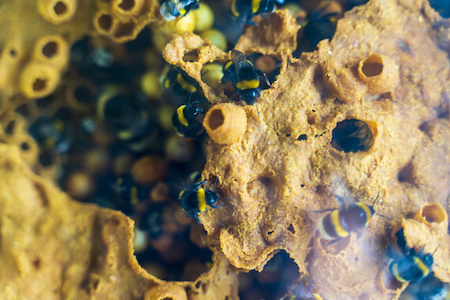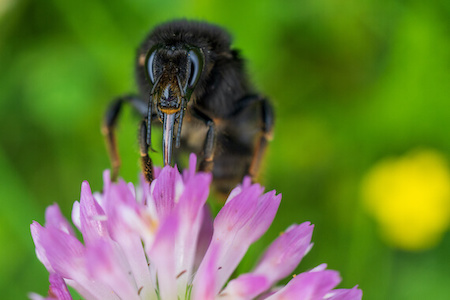
| Kingdom | Animalia |
| Phylum | Arthropoda |
| Class | Insecta |
| Order | Hymenoptera |
| Family | Apidae |
| Tribe | Bombini |
| Genus | Bombus |
| Species | Over 250 species |
| Niche | Temperate social stinging bee |
| Length | Up to 1.6 inches (40 mm) |
| Weight | Up to 0.03 ounces (0.85 g) |
| Lifespan | Males & workers: 2 – 6 weeks, Queens: 1 year |
| Social Structure | Colonies |
| Conservation Status | Species vary from least concern to critically endangered |
| Preferred Habitat | Temperate climates with suitable nesting sites |
| Average Clutch Size | 50 – 400 |
| Main Food Item | Nectar |
| Predators | Badgers, predatory insects, birds & crab spiders |
The Basics
The bumblebee is a group of over 250 species belonging to the genus Bombus. They are found mainly at northern latitudes in North America, Europe, Asia and northern Africa, as well as throughout South America. Bumblebees are characterized by their plump, furry appearance and vary in color from being entirely black to having bright yellow, red, orange, white, or even pink stripes.
Bumblebees are found at higher latitudes and altitudes than most other bees, although a few lowland tropical species do exist. In fact, two bumblebee species that inhabit Ellesmere Island in the high arctic have the northernmost range of any eusocial insect. Bumblebees are able to live in such cold climates thanks to a number of adaptations. For example, their thick pile of long bristles acts as insulation to prevent heat loss during winter. Bumblebees are also able to raise the temperature of their muscles by shivering and can absorb heat even from weak sunshine.
Bumblebees feed on nectar, which is a sugar-rich liquid produced by plants to attract pollinating animals. When bumblebees and other pollinators are foraging for nectar inside flowers, they brush against the reproductive organs of plants and pick up or deposit pollen, thus facilitating fertilization between different individuals. Nesting bumblebee females have specially-adapted pollen baskets on their hind legs, which are areas surrounded by hairs that are used to transport pollen back to the nest to feed bumblebee larvae.

The bumblebee has a long, hairy tongue called a proboscis, which is used to lap nectar from tube-shaped flowers. It is thought that the tip of the tongue acts as a suction cup, allowing nectar to be drawn up via capillary action. Different species have tongues of varying lengths, reflecting their adaptions to forage from different flower species. When bumblebees are in flight or at rest, the proboscis is kept folded up under the head.
Reproduction
Bumblebees are eusocial insects, which means they practice cooperative brood care, division of labor into reproductive and non-reproductive groups and have overlapping generations within a colony of adults. Division of labor creates a caste system in which queens and males are the only individuals to reproduce, whilst female workers carry out a number of tasks such as feeding young and foraging.
Queens are the only bumblebee caste to survive the winter, but do so in hibernation underground. Once spring arrives, queens emerge and each find a place to build their colony, which may be underground in an old burrow or above ground in thick grass or a tree hole. Queens build wax cells in which to lay eggs that were fertilized before hibernation. These eggs develop into female workers, creating colonies that are typically composed of between 50 and 400 individuals. Unlike honeybees, bumblebee nests do not have an organized hexagonal structure, but instead consist of a random jumble of cells.
As a bumblebee colony increases in size, males and new queens begin to be produced. Although worker bees are capable of producing males by laying unfertilized eggs, queens suppress this behavior via physical aggression and pheromones in order to reduce reproductive competition. Queens are the only females that leave the nest to mate with males from other colonies, thus they are the only females able to lay fertilized eggs, which develop into queens and workers. Young queens mate in autumn before they begin feeding intensively to build up fat stores for hibernation. Males and workers die as the weather turns colder and queens begin their hibernation.

Fun Facts about Bumblebees
Bumblebees may look cute and fluffy, but their striking coloration hints at their ability to inflict a painful sting. This adaptation and others provide examples of a number of interesting biological concepts.
Haplodiploidy
Along with all other members of the order Hymenoptera, bumblebee sex is determined by a system of haplodiploidy. In this system, unfertilized eggs only containing genetic information from females develop into haploid males. In contrast, fertilized eggs containing genetic information from both males and females develop into diploid females. The terms haploid and diploid represent the fact that males have half the number of chromosomes as females.
Haplodiploidy is one factor proposed to have driven the evolution of eusociality in bumblebees and other species. This is because in colonies with one queen that mated with only one male, the relatedness between workers is 3/4. This is higher than the typical relatedness of 1/2 for siblings in species with other sex-determination systems. Thus, haplodiploidy is thought to favor kin selection, whereby the reproductive success of closely related relatives is favored over an individual’s own reproductive success as a strategy to propagate their genes in the next generation.

Mimicry
The bright color patterns of bumblebees are aposematic signals that warn other animals of their stinging ability. Different bumblebee species found in the same area tend to have similar color patterns, which is an example of Mullerian mimicry. This type of mimicry is adaptive as it means that other animals only have to learn one warning signal and will avoid all species that look like the one they were previously stung by.
Other non-stinging animal species such as hoverflies and horseflies also exhibit similar color patterns to bumblebees, which is an example of Batesian mimicry. This type of mimicry is adaptive for non-stinging species as predators will avoid any species that looks like one that previously stung them, regardless of whether they are actually dangerous or not.
The Bumblebee’s Sting
Female bumblebees, including queens and workers, are able to sting repeatedly. Unlike honeybees, their stinger lacks barbs so is not left in the wound, thus allowing bumblebees to sting without inuring themselves. Although bumblebees are not aggressive, they may sting to defend their nest or if harmed. The ability to sting is also common in other members of the order Hymenoptera, including many wasp, ant and other bee species. This protective mechanism generally involves an injection of venom, which causes painful reactions of varying severity depending on the species.
